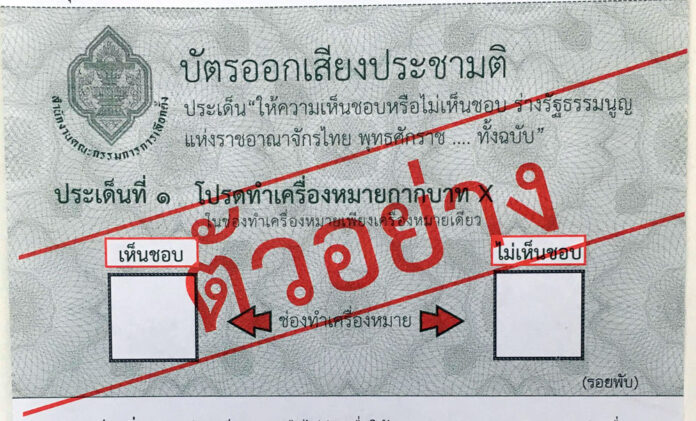
Ed. note: Concerns have been raised about the integrity and credibility of Sunday’s vote in light of the political climate and the exceptional measures taken by the military regime in the run-up to the vote. Pravit Rojanaphruk spoke to top election officials and reviewed their procedures to provide this step-by-step guide to how it’s supposed to play out.
Read: We Took Top Concerns About Sunday’s Referendum to Elections Officials
Ballot boxes and papers will be transported and kept in secured places until referendum day. The roughly 95,000 polling stations will be examined for readiness prior to in the early morning of Aug. 7 before polling starts. Every polling station is supposed to have eight staff: a director, many of whom are school teachers; two security officers, at least one of which is a police officer while the other could be military; and five local volunteers trained for the job.
At around 6am on Sunday, polling staff will arrive at each station carrying ballot boxes and papers to prepare for the polls to open at 8am. It opens with election officers showing that the ballot boxes are empty to the public and voters. They then will seal the ballot boxes with tape and plastic thread or some similar permitted materials before voting commences.
Voters have to affix his or her right hand index fingerprint to the top part of the ballot that will be kept by the Election Commission, or EC. Officials then tear out the ballots with two questions, the top one comprised of two square boxes. Once voters have the ballots, they will use a pen to mark an X sign to the left box if they support adoption of the charter and the right if they reject it. The second question, written somewhat confusingly, is about allowing an unelected prime minister to be selected by the appointed senate jointly with the elected MPs by voting for the five years after the House of Parliament convened. The affirmative answer is the lower left box.
Once the polls close at 4pm, three people – the polling station director, a volunteer and a security officer – will affix their names and signatures on each of the ballot books (which contain 20 ballot papers) to verify that everything is accounted for.
All eight poll workers will then play different roles in the on-site vote counting process. One person will read aloud the counting results which will be marked on a board visible to any observer from outside the polling station.
The final count will then be tallied and reported through Rapid Report, a proprietary app being used for the first time. Only 95 percent of those returns will reported by the central EC in Bangkok. The application, with its names and passwords, are said to only be accessible to each polling station director.
The ballot boxes and papers will then be transported to district-level centers. The results are put together and checked at the center before being sent to the central Election Commission headquarters at the Chaeng Wattana Government Complex in Bangkok.
Anyone at the polling station has the right to object if he or she believes the counting of a particular ballot paper or papers was inaccurate and the poll station director has the duty to stop the count and address the issue on site.
The counting is done once, and a recounting of the whole station can only be done if a citizen files a formal complaint to the EC which the commission deems reasonable.
The Election Commission then has three days to make public the results of the referendum.
We Took Top Concerns About Sunday’s Referendum to Elections Officials















































